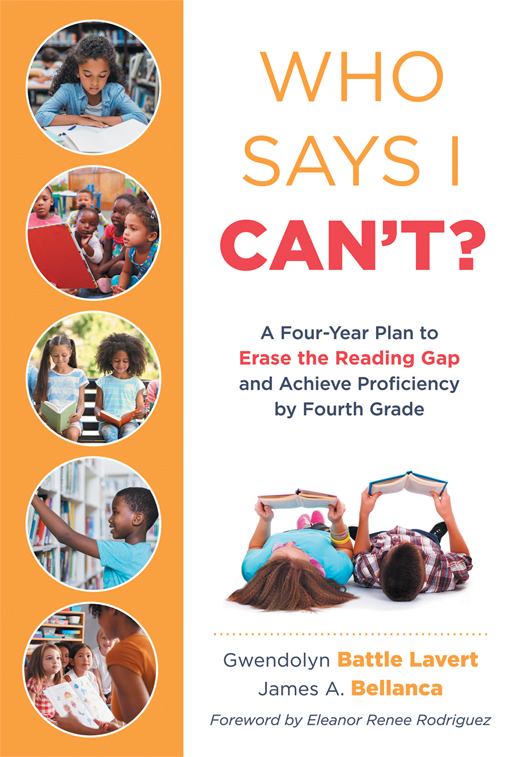Free Reproducibles
Who Says I Can’t?
A Four-Year Plan to Erase the Reading Gap and Achieve Proficiency by Fourth Grade
Discover evidence-based, effective reading strategies to close the reading gap, understand the science of reading, and learn practical techniques for improving reading comprehension, phonics, vocabulary, and critical thinking.
Benefits
- Learn current research on the third-grade reading gap and why it matters.
- Understand the importance of teaching phonics and phonemics in the early grades.
- Explore how to expand vocabulary for students below target levels.
- Guide students on forming meaning in cognitive and metacognitive ways.
- Provide reading material with diverse characters to encourage investment and belonging.
TABLE OF CONTENTS
Introduction: A Necessary Pathway
Chapter 1: Engage With the Learning-to-Read Challenge
Chapter 2: Acknowledge That Yes, It Is About the Brain
Chapter 3: Make Meaning Visible
Chapter 4: Use the Reciprocal Teacher’s Playbook
Chapter 5: Hear It First With Phonemics and Ensure Mastery
Chapter 6: Make the Phonics Connect
Chapter 7: Use Patterns to Achieve Vocabulary Fluency
Chapter 8: Learn to Read for Meaning
Chapter 9: Prioritize Equity
Epilogue: A Dream Revisited
Appendix: Lesson Design Templates and Further Reading
PRINTABLE REPRODUCIBLES
Foreword
Chapter 1: Engage With the Learning-to-Read Challenge
- Figure 1.1: Four-Year Record
- Figure 1.3: Checklist for Introducing New Teaching-to-Read Methods
- It’s Your Turn: Chart of Ideas to Abandon and Adopt
Chapter 2: Acknowledge That Yes, It Is About the Brain
- Figure 2.2: Phonological Competence Graphic Organizer
- Figure 2.5: Learning to Read Essential Outcomes
- It’s Your Turn: Brain Connection Reflection
Chapter 3: Make Meaning Visible
- Figure 3.2: Prerequisite Cognitive Skills—Teacher Assessment of Learning-to-Read for Meaning
- Figure 3.3: Self-Assessment of Cognitive Skills (Grade 1 Phonics Template)
- It’s Your Turn: Instructional Improvement Plan
Chapter 4: Use the Reciprocal Teacher’s Playbook
Chapter 5: Hear It First With Phonemics and Ensure Mastery
- Figure 5.1: Kindergarten Scope and Sequence Instruction, From Hearing It to Saying It
- Figure 5.3: Kindergarten Phonemic Awareness Assessment
- It’s Your Turn: My Action Plan Template
Chapter 6: Make the Phonics Connect
Chapter 7: Use Patterns to Achieve Vocabulary Fluency
Chapter 8: Learn to Read for Meaning
- Figure 8.1: Scope and Sequence for Second and Third Grade
- Figure 8.2: Prerequisite Complex Cognitive Skills for Learning-to-Read for Meaning
- It’s Your Turn: Mediate Complex Cognition and Metacognition Worksheet
Chapter 9: Prioritize Equity
Epilogue: A Dream Revisited
Appendix: Lesson Design Templates and Further Reading
- Figure A.1: Reading Elements and Activities
- Figure A.2: Single-Point Rubric
- Figure A.4: Patterns for Vocabulary
- Figure A.5: Prerequisite Complex Cognitive Skills for Learning to Read for Meaning
SUGGESTED RESOURCES
BOOKS
- Bellanca, J. (2010). 21st century skills: Rethinking how students learn. Bloomington, IN: Solution Tree Press.
- Bellanca, J. (2020). Personalized deeper learning: Blueprints for teaching complex cognitive, social-emotional, and digital skills. Bloomington, IN: Solution Tree Press.
- Conzemius, A. E., & O’Neill, J. (2014). The handbook for SMART school teams: Revitalizing best practices for collaboration (2nd ed.). Bloomington, IN:Solution Tree Press.
- Fogarty, R., & Pete, B. (2020). Metacognition: The neglected skill set for empowering students (revised ed.). Bloomington, IN: Solution Tree Press.
WEBSITES
Chapter 2
Appendix
- A Teachable Teacher
- Songs for Teaching
- Deanna Jump
- Old-Fashioned Jump Rope Songs and Rhymes
- 14 Best Jump Rope Songs & Rhymes (the Ultimate List)
- Favorite Folk Songs for Hispanic Heritage Month
- Spanish Mama
- Free Kids Books
- 15 Picture Books That Celebrate Hispanic & Latine Heritage
- 60 Empowering Books Starring Latina Mighty Girls
- Book List: Picture Books About Muslim or Middle Eastern Characters
- Read Globally: 20 Vibrant Books That Introduce Indian Folktales, Culture, and History to Kids
- Native American Songs
- Musically Montessori: Celebrating the Native American Music & Dance of North America
- Native American Stories
- Native American Folktales for Kids
- Storyberries: Native American
- 36 Children’s & YA Books That Celebrate Native American Heritage
- 10 Wonderful Indigenous Children’s Books to Add to Your Child’s Library
- 30 Asian American Children’s Books
- Popular Korean Children’s Books
- Ukrainian Children’s Books: Recommendations for Publishers
- Favorite Books for Kids With Learning and Attention Issues
- Little Known Black History Fact: Plantation Games
- Informative Games and Activities About Black History
- Fun and Games Teacher’s Guide: About Native American Games
- Native American Games & Activities for Kids
- A Kid’s Guide to Latino History: More Than 50 Activities
- Kids Activities
- Spanish Playground
- 8 Traditional Hispanic Games to Play at Home or in Class
- Spanish Games
- Traditional Arabic Games
- 30+ Multicultural Games & Puzzles
- Diversity Games and School Ideas
- Exploring Cultures in Your Classroom: Activities to Try
- Culturally Responsive Activities

